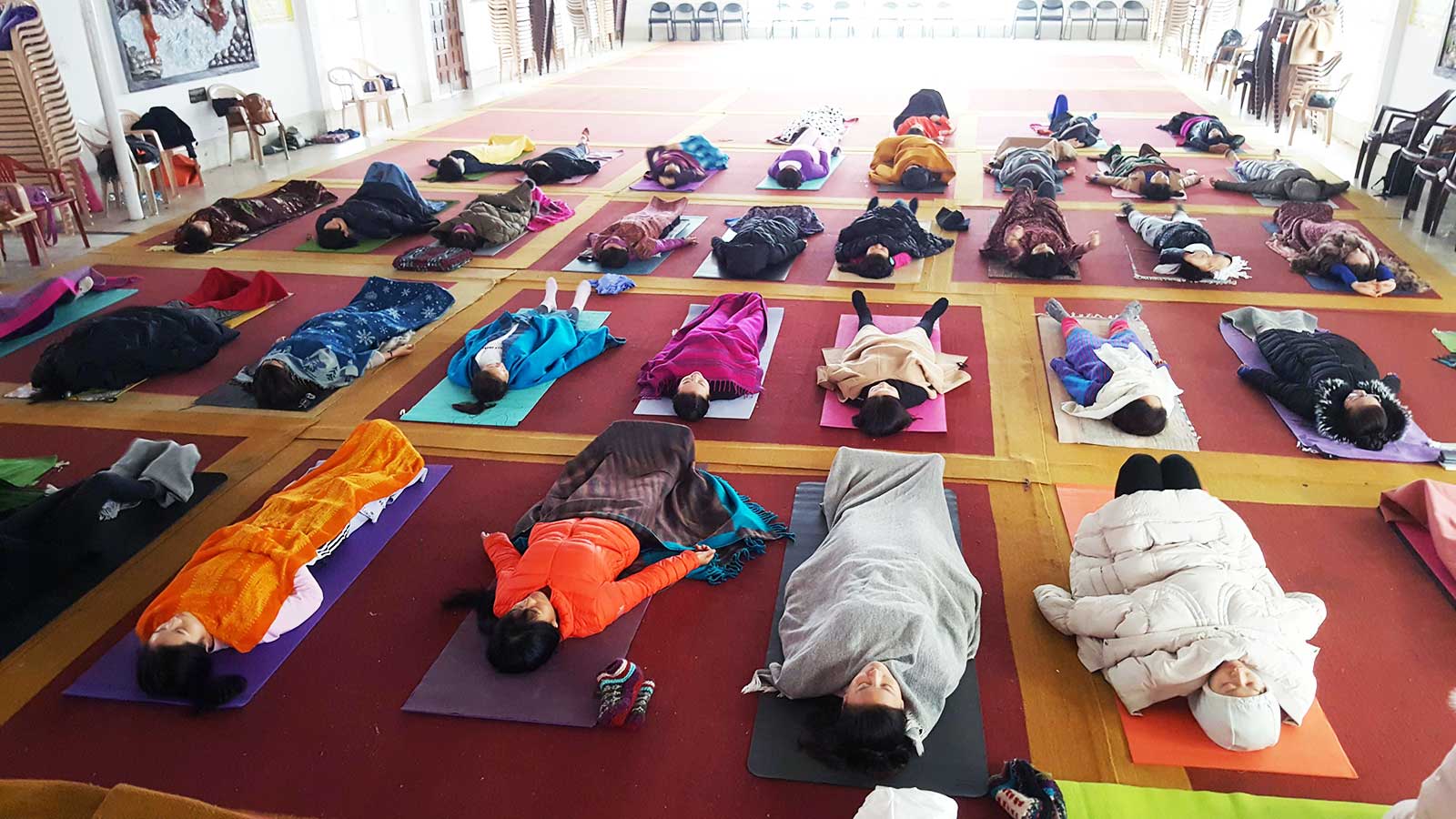
Yogic Sleep is a powerful tool against Stress
Yogic Sleep
Introduction
Yoga Nidra, often referred to as “yogic sleep,” is an advanced relaxation technique that offers profound benefits for the body, mind, and emotions. Derived from ancient yogic traditions, it is a systematic and scientific process of conscious relaxation that facilitates complete physical, mental, and emotional rejuvenation. While it may appear as a simple relaxation exercise, Yoga Nidra has deep transformative potential, helping practitioners restructure and reform their personality from within. This essay explores the essence of Yoga Nidra, its methodology, and the benefits it brings to holistic well-being.
In Yoga Nidra one can learn to relax consciously. It is very systematic and scientific process of complete physical, mental and emotional relaxation. During yogic sleep, you are not only relaxing, but you are restructuring and reforming the whole personality from within. The initial purpose of this practice is to relax the body and mind and when you come to the last stage of the practice you try to dis associate yourself form the body and the mind. We must remember that, stress only affect you when you identify yourself with the body and the mind.
During deep sleep, we don’t remember our name, our body or the nature of our surroundings as well. In the same way, during yogic sleep, after entering a state of deep relaxation, you should try to dis identify yourself emotionally from your body and mind. During this practice one appears to be asleep, but the consciousness is still functioning at a deeper lever of awareness. You can call this state in between wakefulness and sleep.
The Essence of Yoga Nidra
Yoga Nidra is a state of consciousness that lies between wakefulness and sleep. Unlike deep sleep, where awareness is entirely absent, or wakefulness, where the mind is fully active, Yoga Nidra involves remaining conscious while the body and mind experience profound relaxation. In this state, the practitioner disengages from sensory distractions and enters a deeper level of awareness, which facilitates healing, introspection, and transformation.
The practice revolves around achieving a balance between relaxation and awareness. The ultimate goal of Yoga Nidra is to disassociate the self from the body and mind, thereby experiencing a state of detachment that promotes inner peace and freedom from stress. By consciously observing and releasing mental, physical, and emotional tensions, Yoga Nidra offers a pathway to complete relaxation and self-awareness.
Secret of Yoga Nidra
when our mind is totally relaxed, it becomes extremely powerful as it becomes very receptive. On the other side, when our consciousness is connected to all the sensory experiences, the attention is poor and mind tends to jump from one object to another object, resulting poor attention or less receptivity. So, when you withdraw the mind and the sense inward in order to enter into a deep rest, whatever impressions enter the mind at that time would be vey powerful and they will remain there.
In Yoga Nidra, our consciousness is in between the waking and the sleeping stage. This state is known as “hypnagogic stage”. When the practitioner achieves this stage, the mind is exceptionally receptive. Due to this reason, one can use yoga nidra in learning languages or in their studies. Suggestions given to the mind at this stage are used to eliminate unwanted bad habits such as smoking, drinking, violence etc. Probably this is the secret of extraordinary accomplishments of great swamis. It was said about swami vivakenenda that, he could remember a page of any book, once he reads it.
How Yoga Nidra Works
The practice of Yoga Nidra is highly structured, following a sequence of steps that guide the practitioner into progressively deeper states of relaxation. Each step is designed to address specific layers of tension—physical, mental, and emotional—ultimately leading to a profound state of inner stillness.
1. Preparation
The practice begins with the practitioner lying down in Shavasana (corpse pose), ensuring the body is completely comfortable. The environment is kept quiet, with dim lighting to minimize sensory distractions. Relaxing the body is crucial as it serves as the foundation for entering deeper states of awareness.
2. Sankalpa (Resolve)
The next step involves setting a Sankalpa, or a positive affirmation, which acts as a seed planted in the subconscious mind. This resolve could be related to personal growth, emotional healing, or breaking a habit. The Sankalpa is a brief, clear, and positive statement that aligns with the practitioner’s aspirations.
3. Rotation of Consciousness
In this stage, the practitioner’s awareness is systematically guided through different parts of the body. This rotation of consciousness not only promotes physical relaxation but also enhances the practitioner’s ability to focus and remain present. The systematic nature of this process ensures that no part of the body is neglected, leading to a holistic relaxation experience.
4. Awareness of Breath
The practitioner is then guided to focus on their natural breathing patterns. This step deepens relaxation by anchoring the mind to the rhythm of the breath, which also helps disengage from external distractions. As the breath slows and becomes more rhythmic, the mind and body move closer to the yogic sleep state.
5. Visualization
Visualization is an integral part of Yoga Nidra, where the practitioner is guided to imagine specific scenarios, images, or symbols. This step activates the subconscious mind, allowing it to process and release deep-seated emotions or stressors. The visualizations often evoke positive or neutral imagery to create a sense of calm and mental clarity.
6. Dissociation from Body and Mind
The final stage involves disassociating from the body and mind. The practitioner consciously detaches from physical sensations, thoughts, and emotions, entering a state of pure awareness. In this state, the practitioner is neither fully awake nor asleep but remains aware at a deeper, subtler level.
Yoga Nidra and the Detachment from Body and Mind
A unique aspect of Yoga Nidra is its focus on detachment from the physical body and mind. During the practice, individuals are encouraged to dissociate from their physical and mental identities. This detachment is not about escaping reality but about recognizing the true essence of the self as distinct from the body and mind.
For instance, in deep sleep, we lose awareness of our body, surroundings, and even our identity. Similarly, in Yoga Nidra, after achieving deep relaxation, practitioners disidentify from their physical and mental selves, accessing a state of pure consciousness. This experience fosters a profound sense of liberation, as individuals realize they are not confined to their bodily or mental limitations.
Stress, in its essence, arises from identifying too closely with the body and mind. Yoga Nidra teaches practitioners to step back from this identification, offering freedom from stress and emotional turmoil.
Benefits of the Yogic Sleep/Relaxation:
1. Physical Relaxation
Yoga Nidra provides complete physical relaxation by releasing tension stored in the muscles and tissues. By systematically guiding awareness through the body, the practice encourages deep rest and rejuvenation, often equivalent to several hours of regular sleep.
2. Emotional Balance
The practice allows practitioners to address and release unresolved emotions. By accessing the subconscious mind, Yoga Nidra helps process suppressed feelings, leading to emotional healing and balance. It is particularly effective for individuals struggling with anxiety, depression, or stress-related disorders.
3. Mental Clarity
In the modern world, where overstimulation and overthinking are rampant, Yoga Nidra offers a respite. By calming the mind and reducing mental chatter, it enhances focus, concentration, and decision-making abilities. The practice fosters a state of mental clarity that is invaluable for personal and professional life.
4. Stress Relief
Stress affects both the body and mind, often manifesting as physical ailments or emotional instability. Yoga Nidra addresses the root cause of stress by calming the nervous system and promoting the release of endorphins, the body’s natural stress-relievers. Regular practice reduces cortisol levels and creates a lasting sense of calm.
5. Improved Sleep Quality
Many individuals struggle with insomnia or poor sleep quality due to stress or an overactive mind. Yoga Nidra, often referred to as “yogic sleep,” mimics the restorative effects of deep sleep. Practicing it before bedtime helps the mind unwind, leading to better and more restful sleep.
6. Enhanced Self-Awareness
Yoga Nidra fosters a deeper connection with oneself. By observing thoughts and emotions without judgment, practitioners develop greater self-awareness and a heightened understanding of their inner world. This self-awareness is instrumental in personal growth and transformation.
Yogi Prakash
Rishikesh Yoga Prakash









